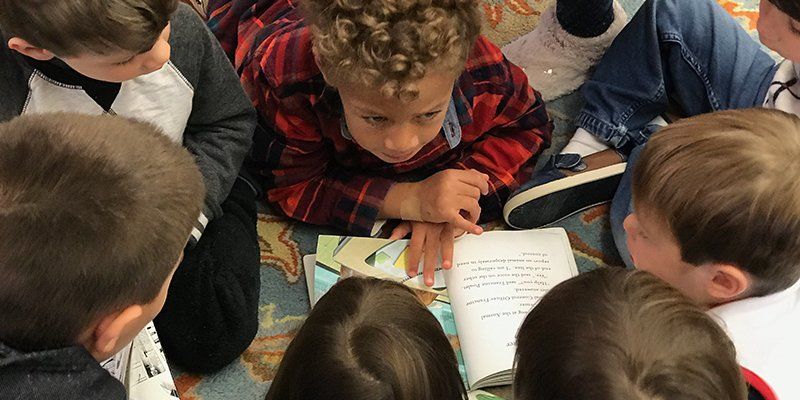Can Montessori Boost Your Child's Success?
Meagan Ledendecker • August 17, 2024

Many of us choose Montessori for our children because we appreciate how the approach respects children as people and as learners. We love how the structure, materials, and lessons appeal to the developmental nature of our children. But how does it affect children in the long-term?
Plenty of people are noticing the positive effects of a Montessori education and researchers are paying closer attention in recent years. For anyone who has been involved with the philosophy for any length of time, the results are not surprising. If you are interested in reading more about current research findings, check out this website.
The big question that remains is, will Montessori children grow up to become successful later in their lives? We may want to start by examining our definition of success. Is success the ability to score well on tests? To be empathetic? To be an innovator? Regardless of how we define the word, research indicates that Montessori does seem to give kids a leg up.
Did you know that many creative, innovative, and successful people who have and continue to shape our world attended Montessori schools? Read on for a list of just some of those individuals.
Julia Child
Where would Americans have found their fondness for French cooking if not for Julia Child? Her books, television show, and the realness of her delivery made a huge impact on households across the country. Child credited Montessori with teaching her to love working with her hands.
Jeff Bezos
For better or for worse, most of us recognize Bezos’ name as he is the founder of Amazon, the world’s largest online retailer.
Prince William and Prince Harry
The sons of Prince Charles and Princess Diana both attended Montessori schools as children.
Gabriel Garcia Marquez
The Nobel Laureate who wrote One Hundred Years of Solitude and Love in the Time of Cholera has said, “I do not believe there is a method better than Montessori for making children sensitive to the beauties of the world and awakening their curiosity regarding the secrets of life.”
Anne Frank
Famous for the penning of her diaries written while she was in hiding during World War II, Frank was a Montessori student.
Larry Page and Sergey Brin
The co-founders of Google have been vocal advocates for Montessori. In 2012, there was a Google doodle dedicated to Montessori. Page has said, “I think it was part of that training of not following rules or orders, and being self-motivated, questioning what’s going on in the world in and doing things a little bit differently.” Check out this short video of Barbara Walters interviewing Larry Page and Sergey Brin
Sean “Diddy” Combs
Best known as a rapper, Combs has also worked as a talent director, songwriter, record producer, actor, and entrepreneur. He once said, “I feel like I was nurtured into wanting to be somebody special.”
Dakota Fanning
Fanning is an actress credited as being the youngest ever nominated for a Screen Actors Guild Award for her performance in the film I Am Sam
at age seven. She has starred in many celebrated films since.
Will Wright
Wright is a well-known video game designer, and creator of games such as The Sims, SimCity, and Spore. He says that children “can become interested in pretty complex theories, like Pythagorean theory, say, by playing with blocks. It’s all about learning on your own terms, rather than having a teacher explain stuff to you. And when kids discover these things on their own, what they learn sticks with them so much more.”

Did you know that the word "grammar" evolved from "glamour"? This linguistic connection reflects an ancient association between language and enchantment. When we introduce Montessori's sentence analysis work, we offer more than just a lesson—we present an enchanting gift! We regularly witness children falling in love with language as they uncover its patterns and structures. At the elementary level, children possess a reasoning mind, an active imagination, and a deep need for communication. The Montessori sentence analysis activities appeal to these characteristics, helping children connect as they creatively discover the underlying patterns of our language. Why Do We Teach Sentence Analysis in the Elementary? Children are natural pattern seekers. They love to identify and understand structures in the world around them, including language. We want them to fall in love with language. By engaging in hands-on grammar work, children develop an appreciation for the beauty of sentence construction. Sentence analysis provides clarity. Understanding sentence structure helps children write with greater precision and confidence. Analysis leads to synthesis. When children break down sentences, they gain the tools to build more complex and meaningful expression in their own writing. What Sentence Analysis Involves The elementary sentence analysis materials introduce a set of symbols (that correlate to what children have experienced with the Montessori grammar boxes and the symbols for parts of speech), along with color-coded arrows with questions on one side and grammatical names on the other. When breaking apart the parts of the sentence, children first identify what brings the sentence to life: the verb (predicate). To identify the subject of the sentence, children ask the questions from one of the arrows emanating out from the action: Who is it that? What is it? By answering those questions, the children are able to determine the subject. Let’s use a very simple sentence as an example: Josie jumped. The children first identify the action: jumped. They can underline this word in red and then can cut it out or tear it out in order to be able to place the word on the red predicate circle. Then they use the black arrows to answer the question: Who is it that jumped? Josie!









